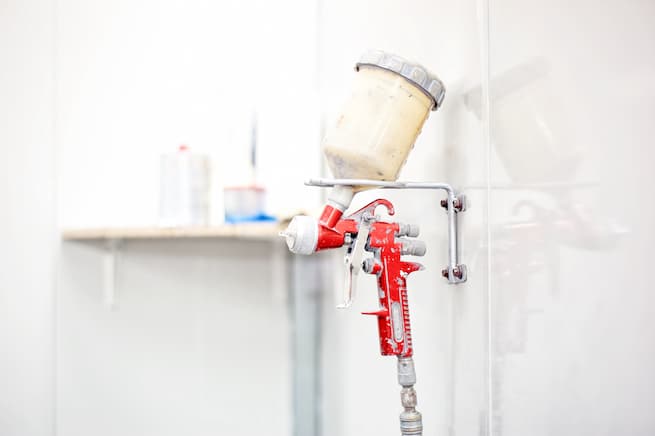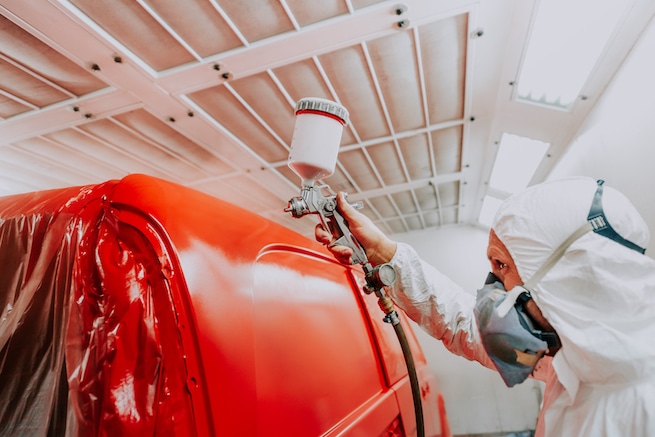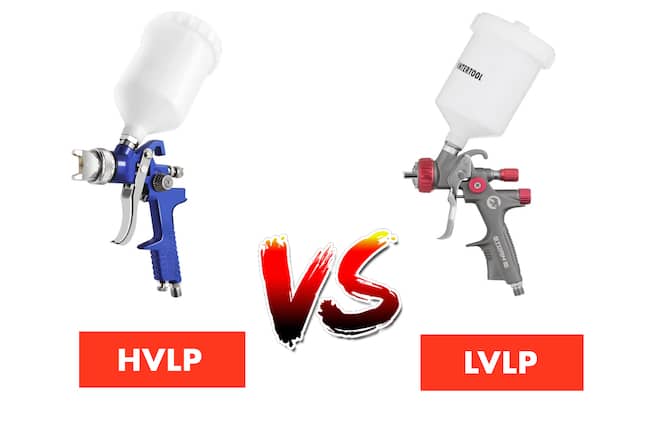12 Disadvantages Of HVLP Spray Gun Every Pro Should Know
As a DIYer, you’ve probably considered using an HVLP spray gun for your next project. After all, it looks like the perfect tool to finish off any woodworking or automotive job with professional-looking results. But before you invest in one of these guns, there are some essential disadvantages of HVLP spray gun that you need to know about.
Precision is key when working on intricate projects such as furniture painting or auto bodywork, and achieving good coverage requires skill and practice.
Unfortunately, traditional airbrushes do not offer the same level of control over paint application compared to HVLP guns—which could mean costly mistakes due to uneven coverage or overspray if you are inexperienced with their use.
Additionally, even experienced users may find themselves struggling with clogs caused by thicker paints and fillers, which require frequent cleaning of the nozzle during use—not ideal when time constraints come into play.
Despite these potential issues, many opt to go for the advantages offered by an HVLP spray gun, such as improved accuracy and faster painting times than with traditional tools; however, it’s important to be aware of both sides before investing in one yourself.
Read ahead for more information on how using this specialized tool can impact your projects positively and negatively so that you can make a confident choice when considering its use in future jobs!
What Are HVLP Spray Guns?

An HVLP spray gun, also known as a “High Volume Low-Pressure spray gun“, is a type of paint application tool that uses a combination of high-volume airflow and low pressure to atomize and deliver paint or coating onto a surface.
HVLP spray guns are commonly used in various industries, including the automotive industry, refinishing, woodworking, furniture restoration, and general painting applications. This technology’s main idea is to use pressure to spray paint.
HVLP spray guns offer a notable advantage compared to other airless paint sprayers: they can be used for interior and exterior painting, while other types are primarily suited for indoor projects. This versatility makes HVLP spray guns a more versatile choice for various painting applications.
Major Drawbacks of HVLP Paint Spray Guns
Here are the main drawbacks of using the HVLP paint Spray Gun:
Limited Speed
HVLP spray guns are known for their slower application speed compared to other types of spray guns. This is primarily due to the low-pressure output of HVLP systems.
While conventional spray guns operate at higher pressure levels, HVLP paint guns deliver a higher volume without having to produce more air pressure. As a result, the paint or coating is applied more gently and with less force.
The slower application speed of HVLP spray guns can be a disadvantage, particularly for large-scale projects requiring significant surface coverage.
Since the coating is delivered at a lower pressure, it takes more time to cover a given area than a higher-pressure system.
For example, when painting a large wall or a large piece of furniture, the slower application speed of an HVLP spray gun can lead to extended painting times.
This can be a significant drawback for professional painters or industries where efficiency and productivity are crucial.
Overspray
Overspray is indeed a common disadvantage of HVLP (High Volume Low Pressure) spray guns. HVLP paint sprayers use a higher volume of air to atomize the paint or coating, which can result in significant overspray during the spraying process.
Overspray occurs when the atomized particles of paint or coating are carried by air beyond the target surface, leading to wastage and potential issues.
The higher volume of air generated by HVLP systems can disperse the particles over a wider area, causing them to spread beyond the intended target. The consequences of overspray include:
Wasted Material
Overspray means that a significant amount of paint or coating is not effectively deposited onto the intended surface. This can result in unnecessary waste of expensive materials, leading to increased costs for the project.
HVLP sprayers come with better transfer efficiency, which can result in the use of less paint due to the lower air pressure spray pattern. A good HVLP gun produces less overspray when painting cars.
Environmental Impact
The overspray particles that are not captured on the target surface can remain in the air or settle on surrounding objects.
This can have negative environmental implications, especially if the paint or coating contains harmful chemicals or pollutants.
Cleanup and Maintenance
Excessive overspray can create a messy work environment, requiring additional cleaning time and effort. The air cap of these paint guns tends to be clogged with paint droplets from any previous paint job.
It may also necessitate regular maintenance of equipment and surrounding areas to prevent buildup and ensure the proper functioning of the spray gun. The paint cup on these HVLP paint sprayers will also need to be cleaned up.
Health and Safety Concerns
Overspray can create an inhalation hazard for the operator and other individuals in the vicinity.
Fine particles suspended in the air can be breathed in, potentially leading to respiratory issues. Proper ventilation and personal protective equipment (PPE) are necessary to mitigate these risks.
Limited Coverage
Limited coverage is another disadvantage of HVLP spray guns. A low pressure output of HVLP systems can result in challenges when it comes to covering certain surfaces, especially those with intricate details or tight corners.
Low Pressure
The lower pressure may not provide enough force to effectively reach and cover areas that are difficult to access or have complex shapes.
Reduced Atomization
The lower pressure in HVLP systems can impact the atomization process, which is crucial for achieving a fine and even spray pattern.
In areas with intricate details or tight corners, the lower pressure may not allow for adequate atomization, resulting in uneven coverage or areas with a lack of paint or coating.
Limited Distance
HVLP spray guns typically have a shorter spray distance compared to higher-pressure spray guns.
This means the operator needs to work relatively close to the sprayed surface to ensure proper coverage.
In situations where access is limited, such as inside narrow crevices or corners, it can be challenging to achieve uniform coverage with an HVLP gun.
Other Disadvantages of HVLP Spray Guns

HVLP spray guns also have their fair share of disadvantages. In addition to the limitations discussed earlier, several other drawbacks are worth considering.
Here are some factors that contribute to limited coverage with HVLP spray guns:
Difficulty with Thick Coatings
HVLP spray guns may have difficulty handling thick coatings or materials with high viscosity. The low-pressure output can result in inadequate atomization and uneven application.
Need for Thin Coatings
Coatings often need to be thinned to achieve optimal results with an HVLP spray gun. This can be time-consuming and may require additional equipment, such as a viscosity cup, to ensure the right consistency.
Dependency on Air Compressor
HVLP spray guns require an air compressor to operate effectively. This adds to the overall cost and complexity of the spraying setup.
Difficulty with Vertical Surfaces
HVLP spray guns may struggle with vertical surfaces, as gravity can cause the paint or coating to run or sag before it dries. This can result in an uneven finish.
Potential for Clogging
HVLP spray guns can be more prone to clogging, especially if the paint or coating contains particles or impurities. Regular cleaning and maintenance are necessary to prevent issues.
Cost
HVLP models can be relatively expensive compared to other spray guns. Additionally, the need for an air compressor adds to the overall cost of the setup.
HVLP Spray Gun Pros
An HVLP paint sprayer has several advantages that make them a popular choice as opposed to a conventional spray gun. Here are some of the pros of using an HVLP sprayer.
- Fine Finish Quality
- Reduced Overspray
- Environmental and Health Benefits
- Better Control and Precision
- Versatility
- Reduced Paint Waste
Alternatives To HVLP Paint Sprayer Gun Technology: Exploring Better Paint Sprayer
When it comes to painting projects, the traditional air spray gun is not always the best option. HVLP spray guns offer a more efficient and powerful way of spraying paint, but they also come with some drawbacks that need to be considered.
One downside of using HVLP guns like the Pneumatic spray guns is the amount of overspray produced during use. This can cause excessive amounts of paint or other coating material to spread beyond its intended target area, resulting in wasted product and potentially damaging nearby surfaces or objects.
In this case, you may consider airless sprayers. An airless sprayer provides higher levels of paint atomization than other conventional guns. Additionally, because these guns are powered by compressed air from a compressor, there is often an increased risk of fire hazards due to flammable materials used in their operation.
Conventional guns require an air compressor to get high pressure in order to produce efficient coverage. Any professional painter will know how to manage the gun trigger with HVLP guns to get a high-quality finish.
Are HVLP guns better than LVLP spray guns?

Although HVLP sprayers may provide faster coverage than conventional methods such as brushwork or rollers, they require more time for setup and clean-up since each job will involve connecting hoses from a compressor to the gun itself along with changing out various nozzles depending on what you’re spraying.
This added complexity means that if you’re working on smaller jobs where speed is important, other approaches, such as brushing or rolling, might be better suited for those tasks.
In light of all this information about potential downsides associated with HVLP technology, it’s worth considering whether any alternatives could make sense for your particular situation when planning your next painting project.
Consider factors like cost efficiency versus quality results and safety concerns. It should help guide you toward making an informed decision about which approach works best for you going forward!
Conclusion
People must weigh their options carefully before deciding which type of spray gun technology best suits their needs. Air compressors also play a crucial role if you want to get excellent quality coverage and paint faster.
While HVLP guns are relatively affordable, no doubt investing in a higher-quality alternative could save you money in the long run by providing more efficient results with less waste.
Therefore, research and explore all possible options so you can make an informed decision when selecting a spray gun technology for your project. Paint booths are essential if you want to prevent bubbles from forming on the painted surface.
With careful consideration of all factors involved, you should be able to find the right solution suited for both your budget and environmental concerns.
Last Updated on: March 16, 2025

